Although it’s officially the beginning of autumn now (here in the Northern hemisphere) according to the calendar, I’m not ready for summer to end quite yet! Today is a beautiful, warm and sunny day, just like yesterday, and I’m sure there will still be a few more of these to come. So while the sun is shining I’m going to share this little sensory activity we did earlier this summer, which also incorporates some very basic STEAM concepts (STEAM stands for Science, Technology, Engineering, Arts and Mathematics):

PART I:
We took an empty ice cream tub and went out into our garden to collect some flower heads. We found roses, daisys and buttercups, and we talked about their colours, scents, size, textures, names etc. Well, as our Penguin is non-verbal, it was mostly me doing the talking, but I did encourage him to try to repeat some of the words, and he did help with the picking (practising motor skills), examined there smells and so on. We had also done a learning activity the previous day, in which we wrote the flowers’ names, identified their colours, which one’s the biggest or smallest etc. If you like, you could work more thouroughly on those concepts while collecting flowers (or other plant parts) for this activity.
We then went inside, poured some water in our ice cream tub (about 1-2 inches deep), and put it in the freezer.
PART II:
A couple of days later, we took the tub out of the freezer and brought it back out into the garden to examine its frozen contents. Before taking the flowery ice block out, we put the tub on its side and let the sun shine throug the bottom of it while we enjoyed how pretty it looked. To be honest, this only lasted for a brief moment, as Penguin was very keen to get the ice block out. I did manage to get him to help me taking a couple of photos of the frozen flowers, before he grabbed the tub and emptied it out on our pateo.
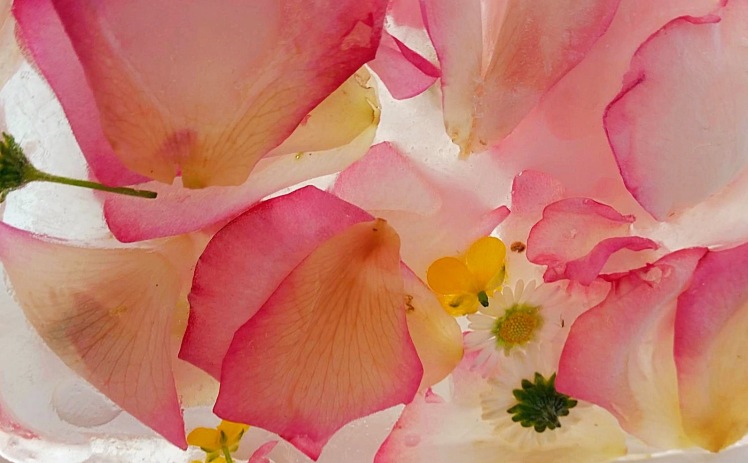
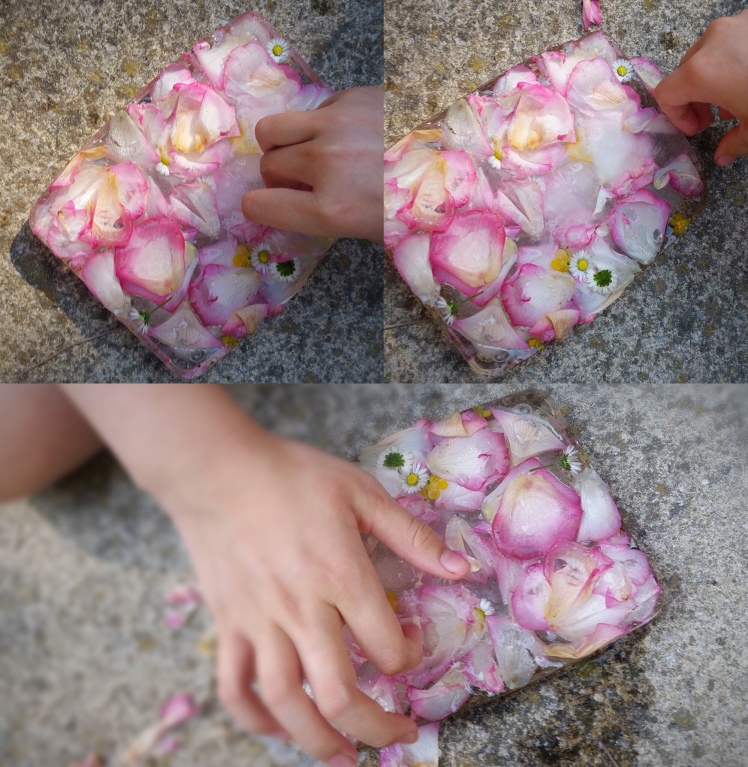
He loved picking away at the ice while it melted. This was a great sensory experience, and an opportunity to really pay attention to what it felt like, as well as to what was happening. Here are some of the things we took notice of, and which you can point out if you do this activity with your child/-ren:
- The ice feels very cold, ice cold.
- The ground (paving slabs) feels warm (I had Penguin put his hand flat on the ground to really feel it). The air is warm too.
- The warmth is making the ice melt, turning it into water. “Notice over here, the ground is dry, but here (by the ice) it’s getting wet.”
- We put water in the tub, it turned into ice in the cold freezer, and now it is getting warmer and turning into water again.
- When water isn’t frozen, it is a liquid. It can flow and move in waves, you can pour it in a glass and drink it. And all the little parts that the water is made of, called molecules, can move when they’re not frozen. But when they get to cold, they get all stiff and can’t move. That’s what happens when the water turns into ice: It goes from liquid to solid. When the ice gets warmer, the molecules can start to move again, so it goes from being solid back to liquid again. (If you like to, you can add that if the water gets REALLY hot, it will turn into gas, in which the molecules are moving around freely all over the place.)
The words in bold letters are ones I emphasized and stopped at to give Penguin a chance to repeat them. I try to incorporate some speech sounds practice here and there, rather than having it as something separate. I think it makes more sense and is more motivating for our boy to work on communication as something that is integrated into other aspects of life and learning.
Next time we do this, we might use Penguin’s AAC app, and find some of the words on there, to ‘say’ them that way instead.
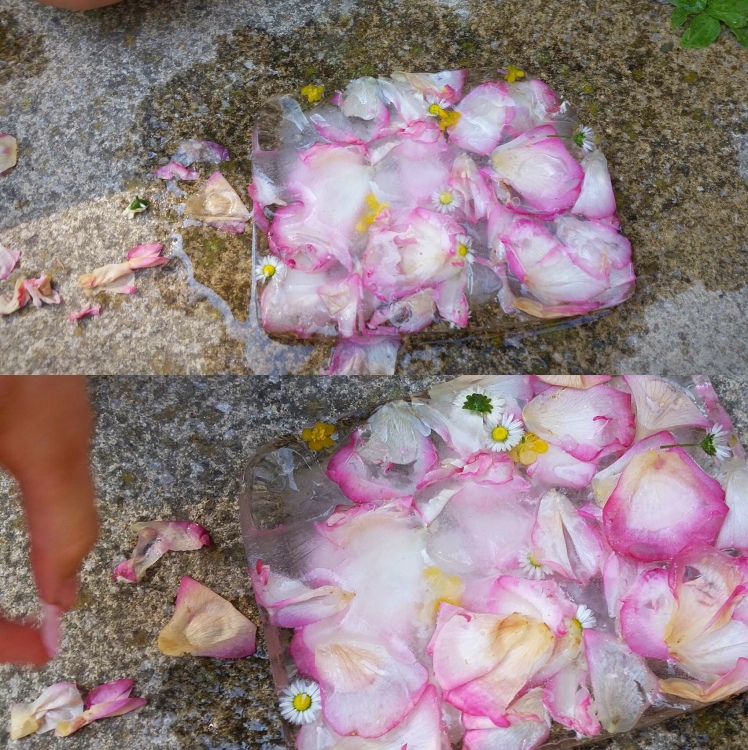
Apart from the changing physical forms of the water, we also looked at the little bubbles that had formed in the ice, and how the ice and the flowers caught the light from the sun. This was mainly just to really notice the beauty of it (a form of ‘mindfulness’, I guess?), but it also gives a chance to use descriptive language, such as “shimmering”, “glittering”, “shining”, “sparkling” and so on. Plus again looking at the colours of the flowers, and repeating their names once more. Repetition plays a super important role for deep learning, you know 😉
For the most part, I let Penguin get on with exploring the melting ice block as he wished, and he got some good pincer grasp practise while trying to pick out the rose petals from the ice. After a little while I suggested we picked it up and dropped it, which we did, and I also got him a trowel to whack the ice with.
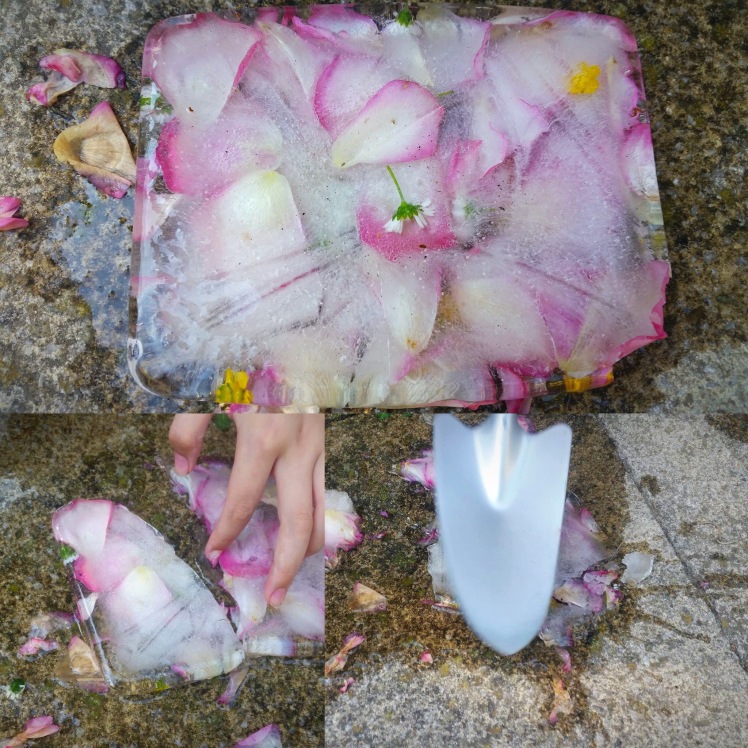
An alternative to taking your frozen flowers out into the garden to melt would be to make part two of this activity part of bathtime. And you might like to make a few extra flower-filled ice blocks while summer is still here. I think it could be pretty sweet to get a sample of summer out of the freezer in a few months time!

*THANK YOU FOR READING! PLEASE JOIN US ON INSTAGRAM, FACEBOOK AND TWITTER, TOO!*
 J
J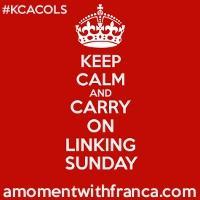



As a former early years practitioner, I love this but would never have thought of it#globalblogging@_karendennis
LikeLiked by 2 people
There’s an almost endless variation to all the things you can do really, isn’t there? Learning can truly be found everywhere. And I’m very grateful for all the amazing inspiration that can be found online, and very happy if we can sometimes inspire others, too 😊 x
LikeLike
This looks fantastic fun! The flowers look so pretty in the ice. #MMBC
LikeLiked by 1 person
Thank you Kim! I do love when fun and learning can be combined in something that is visually appealing too xx
LikeLike
Oh what a clever idea! I’m going to mention this to the school nursery! #kcacols
LikeLiked by 1 person
Thank you lovely! I hope they enjoy it! X
LikeLike
Oh, the flowers look so pretty in the ice, holding their colours. I can see how this works as a sensory exercise. Not surprised Penguin couldn’t wait to get it out of the tub. #MMBC
LikeLiked by 1 person
Thank you so much, Cheryl! Yes, I found it very visually appealing too xx
LikeLike
This is something I would never thought of doing, how lovely to be able to preserve the summer flowers in the freezer, I don’t think their delicate petals would last very long once defrosted though. There is so much to learn from this exercise and it looks fun as well as really pretty.
#MMBC
LikeLiked by 2 people
Thank you! I agree, the flowers won’t last once defrosted. But they do look pretty until then xx
LikeLike
What a brilliant idea, looks a fantastic sensory experience X #mmbc #kcacols
LikeLiked by 1 person
Aaw thank you so much! X
LikeLike
What a lovely idea! Definitely going to try this one with my home ed boy, he’s autistic too and LOVES playing with ice! Thank you so much for the inspiration. x
LikeLiked by 1 person
Thank you! I hope you both have an enjoyable time with this!
Will head over to check your blog out now, too xx
LikeLike
What a lovely idea and it looks so pretty too. Sensory play is so much fun and it looks like Penguin thoroughly enjoyed trying to break his way through the ice!
Thanks so much for sharing with #MMBC. Have a lovely weekend. x
LikeLiked by 1 person
Thank you, Jayne! Yes, it was a pretty successful activity, and one that we’ll happily do again 😀👍 Have a nice weekend, you too! X
LikeLike
This is a great way to open discussions about temperature with little ones and a great summer activity. Thanks for linking up with #globalblogging
LikeLiked by 1 person
Thank you Laura! Yes, it is 😊x
LikeLike
This is a GREAT idea! #thatsatsesh
LikeLiked by 1 person
Aaw, thank you so much! 💖x
LikeLike
I love this, what a great idea! #KCACOLS
LikeLiked by 1 person
Thank you, Sarah! X
LikeLike
What a great activity and so effective too! Really pretty. #kcacols
LikeLiked by 1 person
Thank you lovely! 💕
LikeLike
How beautiful does that ice block look? I love the sound of this activity, and so much learning to be done alongside the fun! #MMBC
LikeLiked by 1 person
Thank you so much, Rachel! X
LikeLike
#thesatsesh I love this, I’m not racking my brain at how i can fit the gas element in to this, plus how pretty is the block! winner for all, great idea.x thanks for joining us, i love your creative play ideas.
LikeLiked by 1 person
Aaw thank you so much!💗xx
LikeLike
Pinned this for later! My daughter would love to try this! #KCACOLS
LikeLiked by 1 person
Thank you so much, Sarah! I hope you both enjoy doing this activity together 💕x
LikeLike
Oh what a great idea, my daughter would love these. Thanks so much for linking up at #KCACOLS. Hope you come back again next time
LikeLiked by 1 person
Thank you Kelly-Anne, that’s lovely to hear! You could do it with some pretty autumn leaves too, as an alternative x
LikeLike
Aaaaw I love this idea !! Looks so pretty too!!! I guess there are all sorts of different things you could freeze , has never occured to me before !! #blogcrush
LikeLiked by 1 person
I’m so glad you like this, we really enjoyed doing it to! It’s simple fun really, and yes, you could adjust it to fit a special interest (or learning letters, numbers etc) depending on what you freeze 😀 xx
LikeLike
And thank you again for the feature!!💖
LikeLike
I so wish I’d have read this at the beginning of the week as Ellis got a homework requiring him to write STEAM facts and I just looked at him blankly and had to call for help on my Facebook 😀 #KCACOLS
LikeLiked by 1 person
Haha 😆 well now you know, and perhaps the activity can come in handy some other time. Thank you for reading and commenting! Xx
LikeLike
I really love this idea! I guess it can also work with leaves! Totally doing this craft. #blogcrush
LikeLiked by 1 person
Thank you! Yes, you could try leaves, or little items relating to something else your child is interested in and/or learning about. The variations can be almost endless, really! Xx
LikeLike
The frozen petals look beautiful! We’re big fans of freezing things in ice to explore. It’s such a great science experiment and lots of fun too. We freeze: LEGO people when playing Super Heroes – you have to save them from the ice, Mini dinosaurs in balloons, as dinosaur eggs (peel the balloon off when frozen), Spooky hands at Halloween, using disposable gloves filled with sprinkles, googly eyes etc (peel the glove off when frozen) #BlogCrush
LikeLiked by 1 person
Thank you Debbie, those are great ideas, and yes the variations possible are almost endless! 😊xx
LikeLike
What a fun idea! We don’t have flowers in our garden, but it would be fun to do with some leaves. Like beets and carrots since they look so different from each other. #blogcrush
LikeLiked by 1 person
Thank you! Yes, leaves are a great idea! Perhaps you could put som thin slices of the actual vegetables in as well, and you can then pair those up with their matching leaves? There are so many variations possible! x
LikeLike
I love the thought that has gone into making this – it’s not just a case of watching the ice melt again, you’ve got loads of ideas of how to spark conversations about it and extend the learning. Thanks! #blogcrush
LikeLiked by 1 person
Thank you Lucy, that’s a very insightful comment 💞xx
LikeLike
Wow those are incredible. I would never have thought to freeze them. Such a great way to learn x
LikeLiked by 1 person
Thank you, Susan! I try to think of ways to stimulate the various senses during learning activities, to make the learning more of a ’whole-body experience’. Also, sensory activities work as a kind of neurological workout, which is likely to be extra helpful for kids with sensory processing differences (which Penguin have as part of his autism) 🙂xx
LikeLike
What a lovely activity, I love how you can turn a sensory activity into a STEM lesson, must do this with my two. Thanks again for linking up to #KidsandKreativity, x
LikeLiked by 1 person
Thanks again, Kerry! I try to make a lot of our learning activities multisensory, as I believe it’s helpful for the brain as well as more fun! 😊xx
LikeLike
I think this would make for a wonderful activity to do with my girls too. Thanks for sharing. #MMBC
LikeLiked by 1 person
Lovely to hear, I hope you all enjoy it! xx
LikeLike